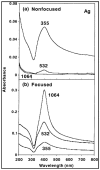The Pros and Cons of the Use of Laser Ablation Synthesis for the Production of Silver Nano-Antimicrobials
- PMID: 30060553
- PMCID: PMC6164857
- DOI: 10.3390/antibiotics7030067
The Pros and Cons of the Use of Laser Ablation Synthesis for the Production of Silver Nano-Antimicrobials
Abstract
Silver nanoparticles (AgNPs) are well-known for their antimicrobial effects and several groups are proposing them as active agents to fight antimicrobial resistance. A wide variety of methods is available for nanoparticle synthesis, affording a broad spectrum of chemical and physical properties. In this work, we report on AgNPs produced by laser ablation synthesis in solution (LASiS), discussing the major features of this approach. Laser ablation synthesis is one of the best candidates, as compared to wet-chemical syntheses, for preparing Ag nano-antimicrobials. In fact, this method allows the preparation of stable Ag colloids in pure solvents without using either capping and stabilizing agents or reductants. LASiS produces AgNPs, which can be more suitable for medical and food-related applications where it is important to use non-toxic chemicals and materials for humans. In addition, laser ablation allows for achieving nanoparticles with different properties according to experimental laser parameters, thus influencing antibacterial mechanisms. However, the concentration obtained by laser-generated AgNP colloids is often low, and it is hard to implement them on an industrial scale. To obtain interesting concentrations for final applications, it is necessary to exploit high-energy lasers, which are quite expensive. In this review, we discuss the pros and cons of the use of laser ablation synthesis for the production of Ag antimicrobial colloids, taking into account applications in the food packaging field.
Keywords: food packaging; laser ablation synthesis in solution; nano-antimicrobials; silver nanoparticles.
Conflict of interest statement
The authors declare no conflict of interest.
Figures












References
-
- Lue J.T. Physical Properties of Nanomaterials. In: Nalwa H.S., editor. Encyclopedia of Nanoscience and Nanotechnology. Volume 10. American Scientific Publishers; Valencia, CA, USA: 2007. pp. 1–46.
-
- Yacoot S.M., Salem N.F. A Sonochemical-assisted Simple and Green Synthesis of Silver Nanoparticles and its Use in Cosmetics. Int. J. Pharmacol. 2016;12:572–575. doi: 10.3923/ijp.2016.572.575. - DOI
-
- Jiménez-Pérez Z.E., Singh P., Kim Y.-J., Mathiyalagan R., Kim D.-H., Lee M.H., Yang D.C. Applications of Panax ginseng leaves-mediated gold nanoparticles in cosmetics relation to antioxidant, moisture retention, and whitening effect on B16BL6 cells. J. Ginseng Res. 2018;42:327–333. doi: 10.1016/j.jgr.2017.04.003. - DOI - PMC - PubMed
Publication types
LinkOut - more resources
Full Text Sources
Other Literature Sources
Molecular Biology Databases
Miscellaneous

